Dr Kawashima’s Brain Training: How Old is Your Brain? Review
Dr Kawashima’s Brain Training: How Old is Your Brain?
It's official - playing games is good for you. Stuart Andrews has fun while he learns with the DS' Brain Training.
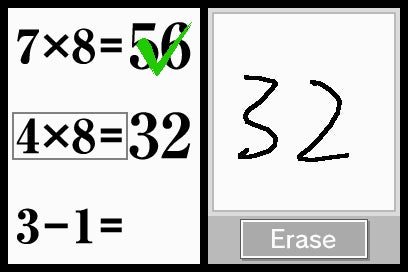
Verdict
Key Specifications
- Review Price: £16.99
Look, Ma, I always told you playing games wasn’t a waste of time. This one is actually good for me.
You see, I’m playing this new Nintendo DS game, Brain Training, and it’s actually reversing the effects of age, diet, booze, poor sleep patterns and general laziness on my tired old noggin. That nice Dr. Kawashima tells me so, and he should know, being one of Japan’s top experts on brain analysis and imaging, and the author of a range of best-selling brain training books. The good Doctor has established ways of testing the current state of my brain, and exercises to put it back in working order. And because it’s a game, it doesn’t feel like any work at all. 
Ingenuously, Brain Training treats your DS like an interactive, electronic book; you tilt your DS on the side, use the left page to read questions, comments and analysis, and the right to write in answers using the touchscreen as a basic text recognition system. It feels so natural that you wonder why nobody thought of this before.
Now you can just try out some of the exercises, just for fun, but don’t be timid, don’t you want to know how dull and muddled your poor brain has become? Start a daily training regime and your first task is to find your brain age, which may be anywhere between the ideal 20 and a not so ideal 80. The game features a range of simple tests that use either text or voice recognition. You may be asked to say the colour of a word onscreen, making sure to say red when the word is coloured red, rather than being ‘red’ if you get my drift. You might also be asked to count all the moving black numbers, the rotating yellow numbers or some other seemingly easy but actually mildly confusing task. At the end of three of these, the game hits you with your current brain age.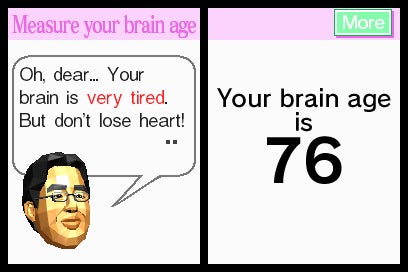
Hang tough – it’s likely to be bad news. I blame the effects of an eight-week old daughter on my sleep, but I only managed a pitiful eighty on my first effort, meaning my mind was only fit to be pensioned off or put to sleep. The trick to getting that brain age down is to come back every day for a training session. A session takes the form of one or more exercises, which might be simple timed arithmetic challenges, reading aloud, or memorising then selecting numbers in a group from the lowest to the highest. Complete one exercise per day and you can stamp the date on the calendar and go away feeling good about yourself. Complete three or more, and you get a larger stamp.
I know, it sounds like homework, but the surprising thing is how much fun this is. Some of that is down to the character of Dr Kawashima, his polygonal face expressing disappointment if you failed to train yesterday, delight when your results start picking up, and commiserating when your performance takes a downturn. And some of it down to the way the game charts your progress in graphs and high score charts, making you feel good when your arithmetic starts improving, or you achieve a personal best in Low to High. Better still, the game rewards progress and perseverance with new exercises and hard versions of existing ones. One minute you’re struggling with the nightmare that is Headcount – a hellish effort where you try to count how many people are in a small house while they are constantly entering and leaving – the next you’ve got your teeth sunk into the hard version, where the gits start flooding down the chimney, too. Don’t even get me started on Triangle Maths….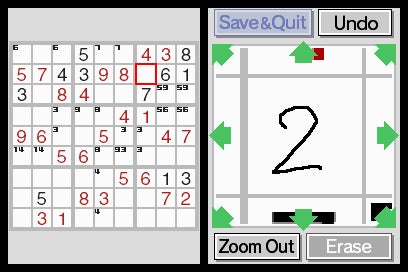
Yet the really great thing about Brain Training is how much fun it is to share. Get two or three people training on the same cartridge, and you’re soon battling for high scores, comparing graphs and grabbing bragging rites on the lowest brain age. Suddenly, it matters that your mate or partner has hit 20, while you’re still struggling around the 25 to 30 mark. And to make this even better, the game throws in draw from memory challenges. Ostensibly, these are to activate your prefrontal lobe, but we all know why Dr Kawashima really put them in: they’re a superb opportunity to snigger at your rivals’ artistic skills. ‘Call that an armadillo? It looks more like a slug on roller-skates’. The game even thoughtfully provides you with a chance for direct comparison in a gallery. I’ve taken the humiliation pretty well, all things considered – as if having a brain age of 80 wasn’t bad enough, I also have the draughtsmanship of a five year old!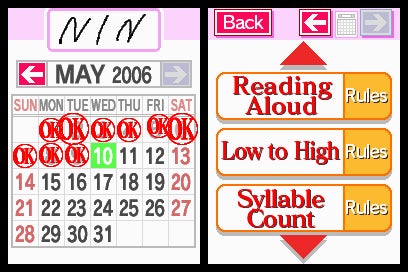
The graphics are purely functional; the audio mostly consists of a range of beeps and alarms, a little background music and the odd smattering of applause, yet somehow the whole presentation feels welcoming and – for want of a better word – jolly. And the game actually manages some impressive technical accomplishments. For a game that relies on text and speech recognition it suffers from surprisingly few errors, and that’s without any sort of calibration. It can’t handle my wife’s Ks or my Is, and the spoken word ‘blue’ can be a sticking point, but it’s coped with a range of spoken accents and handwriting, including mine which used to make grown English teachers quiver with disgust. How many generations of Pocket PC did it take before Microsoft could say the same?
Finally, we lucky Europeans get DS Sudoku thrown in for free. Don’t fret so. It’s easier to get into and more absorbing than you might think – more a test of logic and pattern recognition than mathematic genius. And best of all, it’s guaranteed Carol Vorderman free!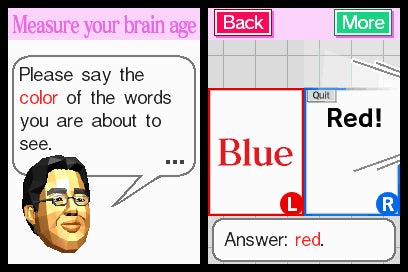
The proof of the pudding? My brain age has now reached a more acceptable 25, and I’m confident 20 is just around the corner. Admittedly, I have a sneaking suspicion that it’s more a case of my brain becoming optimised for the Brain Training tasks than getting any more efficient at anything else but, hey, let’s be positive about this. Brain Training is yet another example of everything that’s good about the DS: it’s cool, innovative, accessible and fun, and it might even persuade those who hate games to have a crack. In fact, it might even be all the ammunition you need to convince your partner (or, hey kids, your parents) that a new DS Lite is what you need. What more can I say? Perhaps just one thing. I HATE maths. I HATED it at school, and I HATE it when I come across it now. Yet the Arithmetic x100 tables have become the most hotly contested high-score tables in the Andrews household. Now wouldn’t my mum be pleased about that…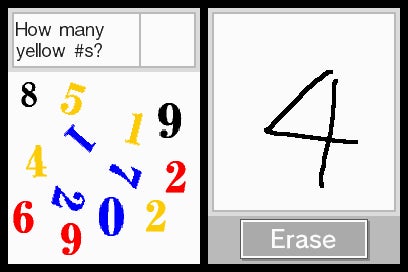
”’Verdict”’
Brain Training sounds odd and dull, but it’s nothing of the sort. Buy it, share it, and give your brain the regular workout it deserves.
Trusted Score
Features
| PEGI Rating | 3+ |
| Genre | Puzzle |
| Player(s) | 1 |

